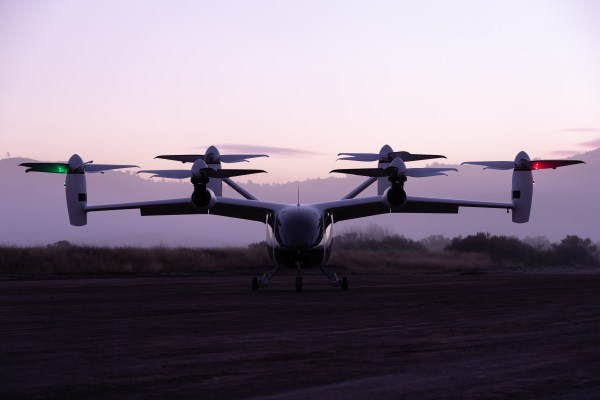Joby Aviation is seeking permission for a series of high-profile air taxi flights over San Francisco Bay, according to documents filed with the FCC and obtained by TechCrunch.
The tests of the startup’s second-generation pre-production prototype, called the S4, would be the first in full view of the public and among the first in an urban environment.
The proposed San Francisco tests are centered around two prime sightseeing points in San Francisco Bay. One is about halfway between the Golden Gate Bridge and Alcatraz Island, the other is south of the Bay Bridge, closer to Alameda.
“We’re currently in the early stages of exploring the potential to perform a limited number of flights,” said Oliver Walker-Jones, Joby’s head of marketing, communications and brand. “We have no confirmed plans yet and securing permission to do so requires us to work with a range of local and federal authorities. That said, this is all very exciting.”
The flights over the Bay would follow a year of record-breaking flights, including the longest (155 miles), fastest (205mph) and, Joby now claims to TechCrunch, the highest ever flights of an electric vertical take-off and landing (eVTOL) aircraft.
“We have recently flown several flights above 7,000 feet (1.3 miles) mean sea level,” said Walker-Jones. All of these flights took place in remote coastal areas and over private land around Santa Cruz, California.
As with its recent record-setting flights, the all-electric, multi-propeller, five-seat S4 aircraft would not be carrying any people. Instead the tests, which would need permission from the FCC, the FAA and city authorities, would be remotely piloted from nearby ground control stations.
Joby’s application notes that flights will typically last an hour, primarily over water, and from sea level up to 5,000 feet. It does not disclose where the aircraft, which have a wingspan of nearly 40 feet and weigh up to 4,400 pounds, will take-off, land and recharge, although Walker-Jones told TechCrunch that it would be on dry land.
Volocopter has flown demonstration eVTOL flights over water in Singapore, and eHang has conducted a few over South Asian cities; Joby’s flights, if approved, would join Beta Technologies in having flown a full-scale air taxi flight in an American city. (Beta has also flown its electric Alia prototype higher and further than the S4, albeit in a conventional airplane mode rather than as an eVTOL).
The stated reason for them is to evaluate the radio equipment used to remotely control the full-size aircraft. “Flight testing is an integral and necessary component of Joby’s on-going efforts to obtain FAA flight certification for new aircraft technology it is developing,” reads the FCC application.
The dramatic public tests are also likely to generate significant media coverage for the company, which went public last summer via a $1.1 billion SPAC deal, and has since seen its stock slide by 50%.
“Testing the radio is the goal of the demonstration flight in that area,” said Walker-Jones. “Of course, in the future we do see some positive benefits to the idea of demonstrating the technology in an urban environment so that people start to see and understand how it fits into where it may eventually operate.”
The tests are also part of Joby’s multi-year $45 million contract with U.S. Air Force, which wants to add cutting-edge eVTOL aircraft into its “strategic capability portfolio.”
Joby now has two S4 pre-production prototypes certified for experimental operation by the FAA and the U.S. Air Force.
Documents filed with the FAA in April 2021 state the first pre-production prototype, which has been flying since October 2019, had completed 562 test flights and logged a flight time of around 27 hours (meaning an average flight duration of less than three minutes), and flown no faster than 80 mph or higher than 1,000 feet.
Joby has blown past those previous records, said Walker-Jones, as part of an “envelope expansion campaign” to gradually explore the aircraft’s potential. Last week, the company said the S4 had slightly surpassed its stated top speed of 200 mph, with a 205-mph test flight, and Walker-Jones said the prototype flew 17 missions over 20 minutes in duration in January alone. The 7,000-foot altitude record, if confirmed, would be much higher than air taxis are generally expected to operate for short intra- and inter-city flights.
According to Joby’s filing with the FAA last April, it expects to build up to four S4 prototypes, and fly up to 600 test flights, over the next two years. It will then move to a final design of the six-motored plane that can meet FAA type certification requirements for commercial operations.
Joby expects to become a certified air carrier this year, before debuting its passenger service in 2024, at that point with fully qualified pilots on board. It signed an agreement with urban real estate company Reef Technology last year to develop rooftop take-off and landing sites on parking structures in the Los Angeles, Miami, New York and San Francisco Bay Area metropolitan areas.
Last September, NASA conducted acoustic tests of Joby’s S4 as it took off, flew and landed. The company expects its aircraft to be more than 100 times quieter than a conventional helicopter, allowing them “to operate around dense, urban areas while blending into the background noise of cities,” according to an SEC filing. NASA and Joby told TechCrunch that those test results had not yet been made public.
In January 2021, Joby acquired Uber’s air transportation startup, Uber Elevate, as part of a $75 million investment by the ride-hailing giant. In a November SEC filing, Joby valued its Elevate assets at just $20 million, with most of the value represented by its automation, multimodal and simulation software.
Joby’s FCC application for the San Francisco tests is still pending.
This article was updated on 1/29/22 to reflect Beta Technologies achievements with its electric Alia air taxi.
